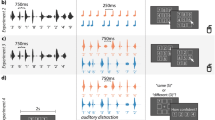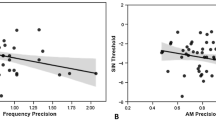Abstract
Recent research has begun measuring auditory working memory with a continuous adjustment task in which listeners adjust attributes of a sound to match a stimulus presented earlier. This approach captures auditory memory's continuous nature better than standard change detection paradigms that collect binary ("same or different") memory measurements. In two experiments, we assessed the impact of different interference stimuli (multitone complexes vs. white noise vs. silence) on the precision and accuracy of participants' reproductions of pitch from memory. Participants were presented with a target multitone complex stimulus followed by eight successive interference signals. Across trials, these signals alternated between additional multitone complexes, randomly generated white noise samples, or (in Experiment 2) silence. This was followed by a response period where participants adjusted the pitch of a response stimulus using a MIDI touchpad to match the target. Experiment 1 found a significant effect of interference type on performance, with tone interference signals producing the greatest impairments to participants' accuracy and precision compared to white noise. Interestingly, it also found a compression in the participants' responses, with overestimations of low-frequency targets and underestimations for high-frequency targets. Experiment 2 replicated results from Experiment 1, with an additional silence condition showing the best performance, suggesting that non-tonal signals also generate interference. In general, results support a shared resource model of working memory with a limited capacity that can be flexibly allocated to hold items in memory with varying levels of fidelity. Interference does not appear to knock items out of a fixed precision slot, but rather robs a portion of capacity from stored items.







Similar content being viewed by others
Notes
Additional post hoc analysis was conducted to rule out the alternative explanation that these effects were the result of participants’ reduced attention/effort to the task in the tone inference condition. Assuming that participants who were not trying would take less time to submit a response, reaction time data was analyzed, and no significant differences were found for reaction time for the tone (M = 4.06, SD= 1.75 ) vs noise (M = 3.74 , SD = 1.64 ) conditions t(23) = 1.75, p = 0.94. The code for this analysis, including the specific results of the statistical test can be found in the MATLAB script “RTExplore” in the supplemental materials.
References
Altmann, E. M., & Gray, W. D. (2002). Forgetting to remember: The functional relationship of decay and interference. Psychological Science, 13, 27–33. https://doi.org/10.1111/1467-9280.00405
Aston, S., Negen, J., Nardini, M., & Beierholm, U. (2021). Central tendency biases must be accounted for to consistently capture Bayesian cue combination in continuous response data. Behavior Research Methods, 54, 508–521. https://doi.org/10.3758/s13428-021-01633-2
Baddeley, A. D., & Logie, R. H. (1999). Working memory the multiple component model. In Miyake & P. Shah (Eds.), Models of Working Memory (1st ed., pp. 28–61). Cambridge University Press. https://doi.org/10.1017/CBO9781139174909.005
Ball, N. J., Wisniewski, M. G., Iyer, N., & Simpson, B. D. (2019). Event-related potential and behavioral correlates of deafness to change in the identity and location of objects in auditory scences. Auditory Perception & Cognition, 2, 1–20.
Banbury, S. P., Macken, W. J., Tremblay, S., & Jones, D. M. (2001). Auditory distraction and short-term memory: Phenomena and practical implications. Human Factors: The Journal of the Human Factors and Ergonomics Society, 43, 12–29. https://doi.org/10.1518/001872001775992462
Bancroft, T. D., Ensor, T. M., Hockley, W. E., Servos, P., & Jones, J. A. (2019). Diffusion modeling of interference and decay in auditory short-term memory. Experimental brain research, 237, 1899–1905.
Bancroft, T. D., Jones, J. A., Ensor, T. M., Hockley, W. E., & Servos, P. (2016). Overwriting and intrusion in short-term memory. Memory & cognition, 44, 435–443.
Bays, P. M., & Husain, M. (2008). Dynamic shifts of limited working memory resources in humanvision. Science, 321, 851–854. https://doi.org/10.1126/science.1158023
Cohen, J., Cohen, P., West, S. G., & Aiken, L. S. (2003). Applied multiple regression/correlation analysis for the behavioral sciences. Routledge
Cousineau, D. (2005). Confidence intervals in within-subject designs A simpler solution to Loftus and Masson’s method. Tutorials in Quantitative Methods for Psychology, 1, 42–45. https://doi.org/10.20982/tqmp.01.1.p042
Cowan, N. (1999). An Embedded-Processes Model of Working Memory. In Miyake & P. Shah (Eds.), Models of Working Memory (1st ed., pp. 62–101). Cambridge University Press. https://doi.org/10.1017/CBO9781139174909.006
Cowan, N. (2001). The magical number 4 in short-term memory: A reconsideration of mental storage capacity. The Behavioral and Brain Sciences, 24, 87–114. https://doi.org/10.1017/s0140525x01003922
Demany, L., Semal, C., & Pressnitzer, D. (2011). Implicit versus explicit frequency comparisons: Two mechanisms of auditory change detection. Journal of Experimental Psychology: Human Perception and Performance, 37(2), 597–605.
Deutsch, D. (1970). Tones and numbers: Specificity of interference in immediate memory. Science, 168, 1604–1605. https://doi.org/10.1126/science.168.3939.1604
Deutsch, D. (1972). Mapping of interactions in the pitch memory store. Science, 175, 1020–1022. https://doi.org/10.1126/science.175.4025.1020
Donkin, C., Nosofsky, R. M., Gold, J. M., & Shiffrin, R. M. (2013). Discrete-slots models of visual working-memory response times. Psychological Review, 120(4), 873–902. https://doi.org/10.1037/a0034247
Fougnie, D., & Marois, R. (2011). What limits working memory capacity? Evidence for modality-specific sources to the simultaneous storage of visual and auditory arrays. Journal of Experimental Psychology: Learning, Memory, and Cognition, 37, 1329–1341. https://doi.org/10.1037/a0024834
Greenspon, E. B., & Pfordresher, P. Q. (2019). Pitch-specific contributions of auditory imagery and auditory memory in vocal pitch imitation. Attention, Perception, & Psychophysics, 81, 2473–2481. https://doi.org/10.3758/s13414-019-01799-0
Hollingworth, H. L. (1910). The Central Tendency of Judgment. The Journal of Philosophy, Psychology and Scientific Methods, 7, 461–469. https://doi.org/10.2307/2012819
Joseph, S., Teki, S., Kumar, S., Husain, M., & Griffiths, T. D. (2016). Resource allocation models of auditory working memory. Brain Research, 1640, 183–192. https://doi.org/10.1016/j.brainres.2016.01.044
Keller, T. A., Cowan, N., & Saults, J. S. (1995). Can auditory memory for tone pitch be rehearsed? Journal of Experimental Psychology: Learning, Memory, & Cognition, 21, 635–645. https://doi.org/10.1037/0278-7393.21.3.635
Kulpa, J. D., & Pfordresher, P. Q. (2013). Effects of delayed auditory and visual feedback onsequence production. Experimental Brain Research, 224, 69–77. https://doi.org/10.1007/s00221-012-3289-z
Kumar, S., Joseph, S., Pearson, B., Teki, S., Fox, Z. V., Griffiths, T. D., & Husain, M. (2013). Resource allocation and prioritization in auditory working memory. Cognitive Neuroscience, 4, 12–20. 10/gjftbx.
Lim, S.-J., Wostmann, M., & Obleser, J. (2015). Selective Attention to Auditory Memory Neurally Enhances Perceptual Precision. Journal of Neuroscience, 35(49), 16094–16104 https://doi.org/10.1523/JNEUROSCI.2674-15.2015
Luck, S. J., & Vogel, E. K. (1997). The capacity of visual working memory for features and conjunctions. Nature, 390, 279–281. https://doi.org/10.1038/36846
Ma, W. J., Husain, M., & Bays, P. M. (2014). Changing concepts of working memory. Nature neuroscience, 17(3), 347–356.
Massaro, D. W. (1970). Retroactive interference in short-term recognition memory for pitch. Journal of Experimental Psychology, 83, 32–39. https://doi.org/10.1037/h0028566
Maybery, M. T., Clissa, P. J., Parmentier, F. B. R., Leung, D., Harsa, G., Fox, A. M., & Jones, D. M. (2009). Binding of verbal and spatial features in auditory working memory. Journal of Memory and Language, 61, 112–133. https://doi.org/10.1016/j.jml.2009.03.001
McPherson, M. J., & McDermott, J. H. (2020). Time-dependent discrimination advantages for harmonic sounds suggest efficient coding for memory. Proceedings of the National Academy of Sciences, 117, 32169–32180. https://doi.org/10.1073/pnas.2008956117
Oberauer, K. (2002). Access to information in working memory: Exploring the focus of attention. Journal of Experimental Psychology: Learning, Memory, and Cognition, 28, 411–421. https://doi.org/10.1037/0278-7393.28.3.411
Pechmann, T., & Mohr, G. (1992). Interference in memory for tonal pitch: Implications for a working-memory model. Memory & Cognition, 20, 314–320. https://doi.org/10.3758/bf03199668
Pfordresher, P. Q., Brown, S., Meier, K. M., Belyk, M., & Liotti, M. (2010). Imprecise singing is widespread. The Journal of the Acoustical Society of America, 128, 2182–2190. https://doi.org/10.1121/1.3478782
Pruitt, T. A., & Pfordresher, P. Q. (2015). The role of auditory feedback in speech and song. Journal of Experimental Psychology: Human Perception and Performance, 41, 152–166. https://doi.org/10.1037/a0038285
Ries, D. T., & DiGiovanni, J. J. (2007). Release from interference in auditory working memory for pitch. Hearing Research, 230, 64–72. https://doi.org/10.1016/j.heares.2007.04.003
Saults, J. S., & Cowan, N. (2007). A central capacity limit to the simultaneous storage of visual and auditory arrays in working memory. Journal of Experimental Psychology: General, 136, 663–684. https://doi.org/10.1037/0096-3445.136.4.663
Schulze, K., & Tillmann, B. (2013). Working memory for pitch, timbre, and words. Memory (Hove, England), 21, 377–395. https://doi.org/10.1080/09658211.2012.731070
Semal, C., & Demany, L. (1991). Dissociation of pitch from timbre in auditory short-term memory. The Journal of the Acoustical Society of America, 89, 2404–2410. https://doi.org/10.1121/1.400928
Soemer, A., & Saito, S. (2015). Maintenance of auditory-nonverbal information in working memory. Psychonomic Bulletin & Review, 22, 1777–1783. https://doi.org/10.3758/s13423-015-0854-z
Williamson, V. J., Baddeley, A. D., & Hitch, G. J. (2010). Musicians’ and nonmusicians’ short-term memory for verbal and musical sequences: Comparing phonological similarity and pitch proximity. Memory & Cognition, 38, 163–175. https://doi.org/10.3758/MC.38.2.163
Wisniewski, M. G., & Tollefsrud, M. A. (2023). Auditory short-term memory for pitch loses precision over time. JASA Express Letters, 3, 034402. https://doi.org/10.1121/10.0017518
Wisniewski, M. G., & Zakrzewski, A. C. (2020). Effects of auditory training on low-pass filtered speechperception and listening-related cognitive load. Journal of the Acoustical Society of America, 148, EL394–EL400. https://doi.org/10.1121/10.0001742
Wisniewski, M. G., Iyer, N., Thompson, E. R., & Simpson, B. D. (2018). Sustained frontal midline theta enhancements during effortful listening track working memory demands. Hearing Research, 358, 37–41.
Funding
Research reported in this publication was supported by the Cognitive and Neurobiological Approaches to Plasticity (CNAP) Center of Biomedical Research Excellence (COBRE) of the National Institutes of Health under grant number P20GM113109. The content is solely the responsibility of the authors and does not necessarily represent the official views of the National Institutes of Health.
Author information
Authors and Affiliations
Corresponding author
Ethics declarations
Conflict of interest
None of the authors reported a conflict of interest.
Additional information
Publisher's Note
Springer Nature remains neutral with regard to jurisdictional claims in published maps and institutional affiliations.
Open Practices Statement
All data and materials for these experiments are available at https://osf.io/62xjb/?view_only=78207e4ecaf4454288f414f439f81e39, and none of the experiments were preregistered.
Supplementary Information
Below is the link to the electronic supplementary material.
Rights and permissions
Springer Nature or its licensor (e.g. a society or other partner) holds exclusive rights to this article under a publishing agreement with the author(s) or other rightsholder(s); author self-archiving of the accepted manuscript version of this article is solely governed by the terms of such publishing agreement and applicable law.
About this article
Cite this article
Tollefsrud, M.A., Joyner, C.N., Zakrzewski, A.C. et al. Not fully remembered, but not forgotten: interfering sounds worsen but do not eliminate the representation of pitch in working memory. Atten Percept Psychophys (2024). https://doi.org/10.3758/s13414-024-02845-2
Accepted:
Published:
DOI: https://doi.org/10.3758/s13414-024-02845-2




